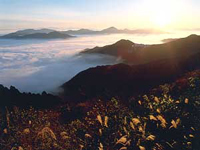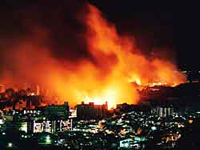Main content starts here.
Welcome to the website of Hyogo Prefectural Government.
This site introduces the overview of Hyogo Prefecture.
|
Links
|
1. Hyogo Prefecture - Gateway to the Asia-Pacific Region
Hyogo Prefecture, situated in the geographical center of Japan, is easily accessible to the world by sea and air. Within Japan, Hyogo Prefecture offers smooth and uninterrupted passage to various cities by extensive expressway, railway, and airline networks.
The Japanese archipelago, shaped like a bow, is located at the eastern end of the Eurasian Continent. Japan consists of four major islands and many smaller ones, and has a diversity of climatic conditions around the country. The Kansai region, in which Hyogo Prefecture is located, has its own economic and cultural features that are distinct from those of the Tokyo metropolitan area.
Blessed with a central location, Hyogo Prefecture has developed quick and easy access to various places throughout Japan and around the world. Moreover, since the opening of the Port of Kobe in 1868, Hyogo has served as a gateway to Japan for the outside world. As access to the Prefecture developed, so did the exchange of cultures. Many aspects of Western culture, such as movies and golf, entered Japan through Hyogo and later spread throughout the country. At the same time, aspects of Japanese culture, such as karaoke and animation, spread from Hyogo to the world.
Kansai International Airport, or KIX, is Japan’s only 24-hour airport. Kobe, Hyogo’s capital, is one of the closest cities to the Airport. The Airport can be reached in approximately one hour from Kobe by express bus.
Kobe Airport, or UKB, has excellent access. It is as little as 16 minutes from downtown Kobe by Portliner and is connected with KIX via a bay shuttle.
The Port of Kobe is a major international trade port. Efforts are being made to develop this port into the Mother Port of Asia.
Major expressways that traverse Japan from east to west and from north to south pass through Hyogo Prefecture. Excellent access is available from Hyogo to cities outside of the Prefecture. Construction of the Akashi Kaikyo Bridge, the world’s longest suspension bridge, was completed in April of 1998, linking Hyogo Prefecture to the island of Shikoku.
One of the world’s fastest trains, the Shinkansen, or bullet train, runs from Kobe to destinations east and west, making the travel time from Kobe to Tokyo only about two and a half hours. In combination with those of Osaka and Kyoto, Hyogo’s extensive transportation system, including various railways such as JR, Hankyu, Hanshin, Sanyo, Kobe Dentetsu, and the Kobe Municipal Subway, make up an integrated commuter sphere in the larger Kansai metropolitan area.
2. Hyogo, Kansai, and the World
Centering around the Port of Kobe, Hyogo Prefecture has developed into a highly internationalized region, now serving as home to many international institutions. Together with Osaka and Kyoto, Hyogo forms the Kansai economic region.
The area centered around Hyogo, Osaka, and Kyoto is called the Kansai region, and it was the center of Japan for over 1,000 years until the capital was moved to Tokyo in 1868. As a result, Kansai is rich with shrines, temples, and historic sites. About half of Japan’s designated national treasures and important cultural properties are located in the Kansai region. The area is also known for its diversified natural beauty, including forests, lakes, and the sea.
Unlike the Tokyo metropolitan area, Kansai is a decentralized region consisting of the three major cities of Osaka, Kobe, and Kyoto. The three cities respectively display features of a commercial city, an international city, and a historic city, forming a great economic sphere. Other large cities as well as smaller cities and towns all contribute to the area’s attractiveness and prosperity. With the global access of Kansai International Airport, the Kansai region is expected to become an international exchange base, mainly for the Asia-Pacific region.
According to ancient Japanese mythology, the Japanese archipelago came into existence with the formation of Awaji Island. This legend shows Hyogo’s considerable contribution to the development of Japanese culture in ancient times. Hyogo has been left with a diversity of historical sites, including Himeji Castle, which was designated by UNESCO as a World Cultural Heritage site.
Historically, Hyogo has played a key role in developing transportation routes on land and by sea, and prospered from domestic and international exchange. Since the opening of the Port of Kobe in 1868, Hyogo has been a gateway to the world, serving as a center of international trade and a hub for international exchange.
In terms of modern day attributes, Hyogo Prefecture serves as an international base for research projects that cover a wide range of areas. Research facilities that have been established in Hyogo include the world’s largest synchrotron radiation facility (SPring-8), the International EMECS Center for environmental management of enclosed coastal seas, and the WHO Kobe Centre, which conducts human health studies. Based on the lessons learned from the Great Hanshin-Awaji Earthquake, research activities for disaster management and prevention are under way at the Disaster Reduction and Human Renovation Institution as well as the Asian Disaster Reduction Center. In addition, various other international research organizations are coming together in Hyogo Prefecture.
3. Hyogo Prefecture-A Japan in Miniature
Hyogo Prefecture extends from the Japan Sea in the north to the Seto Inland Sea in the south, and further down to the Pacific Ocean through Awaji Island.
Hyogo Prefecture contains a rich variety of communities ranging from large cities to rural villages as well as isolated islands, and also has several diversified climatic and natural features. Various leisure activities can be enjoyed here, including swimming, skiing, and bathing in numerous hot springs. As a result, Hyogo Prefecture has become known as a Japan in Miniature. The Prefecture consists of five highly distinctive districts: Settsu (Kobe and Hanshin), Harima, Tajima, Tamba, and Awaji, each of which has its own unique history, climate, and industries.

Serene sea of clouds |
Due to the region’s vast land size, climates in Hyogo vary by region, and can be categorized into three different geographic zones ? the southern area along the Seto Inland Sea, the northern area along the Japan Sea, and the mountainous area in the middle.
The climate in the south is moderate with little rain, while the cloudy and rainy north receives seasonal winds from Siberia in the wintertime and has a lot of snowfall.
Most of the Prefecture’s population ? over 90% ? reside in the urban areas of Kobe, Hanshin, and Harima. Industries such as steel, shipbuilding, and machinery are concentrated in these large urban areas. In contrast, agricultural, forestry, and fishing industries are active in the districts of Tajima, Tamba, and Awaji, against the backdrop of beautiful rivers, mountains, and seas.
As a result of Hyogo’s diversified climate and abundant natural features, swimming and other marine sports can be enjoyed in the summer in various places facing the Japan Sea and the Seto Inland Sea, while in the winter skiing can be enjoyed in Tajima. Also, Arima hot springs, one of the oldest in Japan, as well as Kinosaki and Yumura hot springs, are all popular tourist attractions in Hyogo Prefecture.
In various parts of the Prefecture, traditional culture has been passed down through the generations. There are a variety of enjoyable events, such as the Nada Fighting Festival and Toka Ebisu as well as the Shunsetsusai Festival (Chinese New Year festival) in Nankin-machi (Chinatown). In addition, various events such as the traditional Awaji Ningyo Joruri puppet theater and the all-female Takarazuka Revue can also be enjoyed.
4. Progress Toward Reconstruction From the Great Hanshin-Awaji Earthquake
The Great Hanshin-Awaji Earthquake occurred in January 1995. Since the occurrence of this tragic disaster, various efforts have been made towards “Creative Reconstruction” with the aim of achieving more than merely returning the region to the pre-earthquake state.

Fires after the Earthquake |
The Great Hanshin-Awaji Earthquake, registering a seismic magnitude of 7.3, struck the southern part of Hyogo Prefecture at 5:46 on January 17, 1995. This vertical-thrust earthquake was responsible for the loss of more than 6,400 lives, and severely damaged utility lines such as electricity, gas, and water supply, in addition to houses and urban infrastructure, including expressways, railroads, and harbors. The total damage amount was valued at approximately 10 trillion yen.
Despite difficult conditions, including severed traffic networks and paralyzed urban functions, steady restoration took place through the dedicated efforts of those involved and with generous assistance from around the world. In only six days following the Earthquake, provisional supply of electricity was restored, with water and gas reconnected in three months.
The Priority Three-Year Reconstruction Plan was implemented to press forward the urgently needed reconstruction of living quarters for the victims, and also the restoration of industries and infrastructure such as roads, harbors, and railways. In addition, the Great Hanshin-Awaji Earthquake Reconstruction Plan (Hyogo Phoenix Plan) was formulated with the aim of achieving “creative reconstruction” over a period of ten years. The Phoenix Plan called for not only mere restoration but also the creation of urban communities that meet the needs of the increasingly aging society and Japan’s highly maturing economy.
With the extent of restoration in housing, industries, and urban infrastructure accomplished thus far, the quantitative targets set in the Priority Three-Year Reconstruction Plan were successfully achieved.
On January 17, 2005, the 10th Great Hanshin-Awaji Earthquake Memorial Service was held in the presence of Their Majesties The Emperor and Empress of Japan.
Hyogo continues to exert its utmost efforts to support disaster-hit elderly citizens to regain their self-reliance, create sources of communal vitality, and establish safe and secure communities.
5. Industries
Many foreign-affiliated companies as well as research and manufacturing facilities of a number of major Japanese companies are located in Hyogo Prefecture. Recently, Hyogo is creating a name for itself as a venue of technological innovation and development in fields related to nanotechnology.

Apparel industry |
Hyogo Prefecture is home to internationally renowned companies such as Kawasaki Heavy Industries, Ltd. and Kobe Steel, Ltd. Many major Japanese companies, including Mitsubishi Heavy Industries, Ltd., Toshiba Corporation, Fujitsu Ltd., and Mitsubishi Electric Corporation, locate their research and manufacturing facilities in Hyogo. Hyogo is home to many global niche businesses.
Ranging from natural bounties such as agricultural products cultivated in the region’s vast land area and seafood from the surrounding bodies of waters to traditional crafts and delicious sake and confectionery, Hyogo’s local products are memorable souvenirs that are enjoyed by many visitors.
Hyogo has a variety of tourist places, including scenic sites created by abundant nature, hot springs loved by famous writers and artists, and historic and cultural heritage sites such as Himeji Castle.
For further information, please visit the website of the Hyogo Tourism Association( External link ).
6. International Exchange and Cooperation
Hyogo Prefecture has internationalized and modernized itself with the opening of the Port of Kobe. The Prefecture is making efforts to create cities where international residents can live in comfort, and is addressing various challenges that are common to all of humanity in collaboration with various countries around the world.
Centering around the Port of Kobe which was opened to the world in 1868 (the first year of the Meiji era), Hyogo Prefecture has developed into a cosmopolitan region leading the modernization and internationalization of Japan. Since the opening of the port, the Prefecture has increasingly become a more and more comfortable place to live for non-Japanese residents, offering such conveniences as many housing units designed to international standards, international schools that provide first-class education, hospitals and consulting institutions that offer multilingual services, and many churches. At present, more than 100,000 overseas residents from about 130 countries reside in Hyogo.
The 21st century is a time of great exchange. Just as this new century was dawning, the Great Hanshin-Awaji Earthquake robbed us of many precious lives. During the reconstruction process from the disaster, gracious support was received from all over Japan and abroad, making us realize how important it is for us to live together with other people in the world and help each other.
Some of the problems local governments face today require collective efforts by many regions regardless of the boundaries of districts and nations. Therefore, Hyogo Prefecture is promoting multilateral cooperative frameworks in addition to the traditional bilateral exchange among our overseas sister states and affiliated regions.
Meanwhile, the newly developed Kobe New Eastern City Center has become home to a collection of international institutions that address a wide range of global issues, such as disaster management, environment, health and welfare, and humanitarian affairs.
In addition to the accumulation of international research institutions and collaboration with local governments abroad, the Prefecture encourages the participation and cooperation of non-governmental organizations and companies that engage in activities for international exchange and cooperation. Through such measures, Hyogo Prefecture hopes to contribute to the peace and stability of the world in the 21st century by advancing efforts to solve common issues for all humanity.
For further information, please visit the website of the Hyogo International Association.